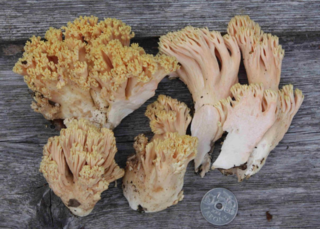
Ramaria formosa, commonly known as the salmon coral, beautiful clavaria, handsome clavaria, yellow-tipped- or pink coral fungus, is a coral fungus found in Europe. It is widely held to be mildly poisonous if consumed, giving rise to acute gastrointestinal symptoms of nausea, vomiting, diarrhea and colicky pain. It is a pinkish, much-branched coral-shape reaching some 20 cm (8 in) high. Similar forms collected in North America are now considered to represent a different species than the European Ramaria formosa.

The genus Ramaria comprises approximately 200 species of coral fungi. Several, such as Ramaria flava, are edible and picked in Europe, though they are easily confused with several mildly poisonous species capable of causing nausea, vomiting, and diarrhea; these include R. formosa and R. pallida. Three Ramaria species have been demonstrated to contain a very unusual organoarsenic compound homoarsenocholine.

Ramaria botrytis, commonly known as the clustered coral, the pink-tipped coral mushroom, or the cauliflower coral, is an edible species of coral fungus in the family Gomphaceae. Its robust fruit body can grow up to 15 cm (6 in) in diameter and 20 cm (8 in) tall, and resembles some marine coral. Its dense branches, which originate from a stout, massive base, are swollen at the tips and divided into several small branchlets. The branches are initially whitish but age to buff or tan, with tips that are pink to reddish. The flesh is thick and white. The spores, yellowish in deposit, are ellipsoid, feature longitudinal striations, and measure about 13.8 by 4.7 micrometers.

The clavarioid fungi are a group of fungi in the Basidiomycota typically having erect, simple or branched basidiocarps that are formed on the ground, on decaying vegetation, or on dead wood. They are colloquially called club fungi and coral fungi.

Thelephora palmata is a species of clavarioid fungus in the family Thelephoraceae. The fruit bodies are leathery and coral-like, with branches that are narrow at the base before widening out like a fan and splitting into numerous flattened prongs. The wedge-like tips are whitish when young, but darken as the fungus matures. The common names of the fungus refers to its pungent odor, likened to fetid garlic. A widely distributed but uncommon species, it is found in Asia, Australia, Europe, North America, and South America, where it fruits on the ground in both coniferous and mixed forest.

Ramaria acrisiccescens, commonly known as the blah coral, is a coral fungus in the family Gomphaceae. It is found in the forests of northwestern North America.

Ramaria fennica, commonly known as the bitter coral, is a coral mushroom in the family Gomphaceae. It is found in Australia, Europe and North America.

Phaeoclavulina abietina, commonly known as the green-staining coral, is a coral mushroom in the family Gomphaceae. It is characterized by the green staining reaction it develops in response to bruising or injury.

Ramaria stricta, commonly known as the strict-branch coral is a coral fungus of the genus Ramaria. It has a cosmopolitan distribution, and grows on dead wood, stumps, trunks, and branches of both deciduous and coniferous trees. Its fruit body is up to 10 cm tall, made of multiple slender, compact, and vertical parallel branches. Its color is typically light tan to vinaceous-brown. All parts of the mushroom will bruise when handled. There are several lookalike corals that can usually be distinguished from R. stricta by differences in coloration, bruising reaction, or microscopic features. The fungus is inedible due to its unpleasant odor and bitter taste.

Ramaria rasilispora, commonly known as the yellow coral, is a coral mushroom in the family Gomphaceae. Described as new to science in 1974, it is found in western North America south to Mexico, and in the eastern Himalaya.

Ramaria araiospora, commonly known as the red coral, is a coral mushroom in the family Gomphaceae. First described in 1974, it is found in North America, and the Himalaya. An edible species, it is sold in local markets in Mexico.
Ramaria conjunctipes is a coral mushroom in the family Gomphaceae. It is found in North America and Thailand.

Ramaria cystidiophora, commonly known as the fuzzy-footed coral, is a coral mushroom in the family Gomphaceae. It is in the Laeticolora subgenus of Ramaria. The branches are yellow, sometimes brighter at the tips, growing from a fuzzy white stem. The odour is sweet.

Ramaria sanguinea, commonly known as the bleeding coral or the bloody coral, is a coral mushroom in the family Gomphaceae.

Ramaria rubrievanescens, commonly known as the fading pink coral, is a coral mushroom in the family Gomphaceae. It is found in North America.

Ramaria vinosimaculans, commonly known as the wine-staining coral, is a coral mushroom in the family Gomphaceae. It is found in North America.

Ramaria rubripermanens is a species of coral fungus in the family Gomphaceae. Described as new to science in 1973, it is found in the western United States and Mexico. Its fruit bodies, which resemble sea coral, grow up to 16 cm (6.3 in) tall and feature whitish to light yellow branches with pinkish to reddish tips. It is edible.

Ramaria magnipes is a coral fungus in the family Gomphaceae. It is found in western North America, where it fruits on the ground in mixed forests.

The genus Phaeoclavulina comprises approximately 55 species of coral fungi.

Ramaria gracilis is a species of coral fungus in the family Gomphaceae.



















